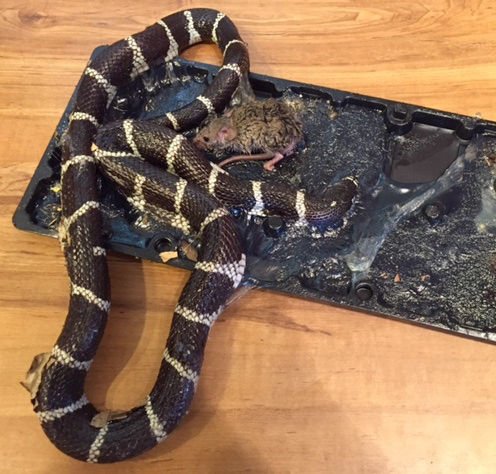GOTCHA! That’s what the hungry young California kingsnake was likely thinking as he struck at the field mouse sitting in a shiny tray. But it was a double-gotcha. Both critters became immobilized victims of that device of torture … the glue trap. Despite the manufacturers’ assertions that the traps are a “humane” way to rid homes and yards of pests, the homeowner was horrified by the sight of the struggling 35-inch long snake and the truffle-sized mouse and brought them, still stuck in the glue, to the Wildlife Education and Rehabilitation Center.
WERC staff delicately and patiently removed the snake from the glue and then cleaned off as much of the mess as possible. It required several baths in special solutions and still left the snake feeling sticky. It will take at least several more weeks until the snake completely sheds his old skin and becomes his normal glossy self. In the meantime, he is eating voraciously … 12 (dead) mice in one week.
Glue traps—aka glue boards and glue strips—are indiscriminate killers. Not only do they trap targeted rodents, but also songbirds, squirrels, reptiles and other small wildlife. They die from struggling to free themselves or from starvation when they can’t. According to the Humane Society, glue boards are responsible for more suffering than virtually any other wildlife control product on the market. Most animals caught in glue boards suffer slow and agonizing deaths. Removing them from the trap and cleaning the horribly sticky glue from the feathers, fur and scales causes such acute stress to the animals that many soon die despite intensive treatment.
A month ago, a cliff swallow was brought to WERC stuck in a type of trap made of an extremely oily and rubbery glue. Despite treatment, that beautiful bird didn’t make it. Also several doves recently suffered from the same results.
Another casualty of the dastardly devices was a young screech owl out hunting one night, who spotted a rodent that had been caught in a glue trap. Alas, the little owl also became stuck. The skin on its foot was ripped away and the leg became gangrenous. Sadly, it was necessary to euthanize the poor bird.
Much more fortunate was the male adult house sparrow that arrived in June and was lucky to survive—minus his tail, which had been completely pulled out by the glue. He was released to his original habitat after the owner promised to rid the property of glue traps.
Controlling rodent populations should focus on the removal of the cause and source and changing the conditions that caused the animal to move in with you in the first place. To learn more about the humane approach to wildlife control go to humanesociety.org/animals/wild_neighbors.
As for the tiny mouse … she is one very lucky rodent. The glue was successfully removed from her fur and feet. After several days recuperating from the trauma and being fattened up with delicious mouse food, she was released to a volunteer’s backyard where she will never again encounter a glue trap or poison.















